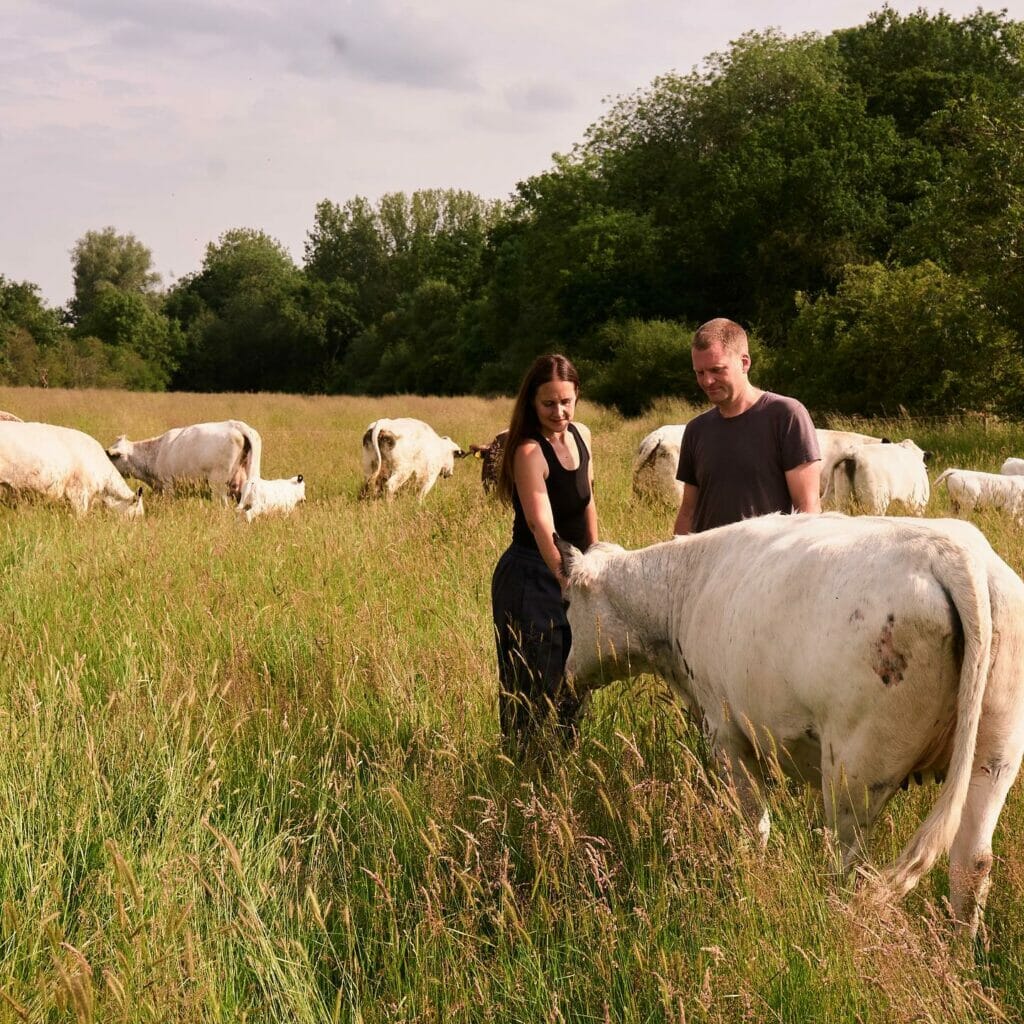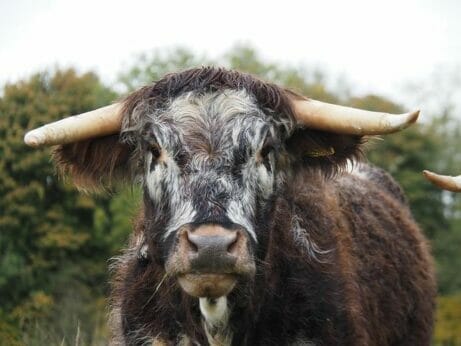Meet the Modern Graziers Who Broke Into Regenerative Agriculture, No Farmland Required
As new entrants to farming, James and Katie Allen didn’t have access to land ownership, but they followed their passion anyway.
Meet the Modern Graziers Who Broke Into Regenerative Agriculture, No Farmland Required
As new entrants to farming, James and Katie Allen didn’t have access to land ownership, but they followed their passion anyway.

Lacking farmland of their own, James and Katie Allen had to get creative to break into farming.courtesy of Heritage Graziers.
When James Allen and his wife, Katie, started Heritage Graziers in the summer of 2015, they didn’t own any pasture or farmland, and neither had a background in agriculture. While their personal interest had led them to keep some livestock at their home in England—a few sheep here, a few pigs there—Katie worked in marketing and James in computer programming. If they wanted to grow beyond those few animals and break into the farming life in earnest, they would need to get creative.
Across the U.K., farms often stay tied to families or corporations, and farmland is notoriously difficult to purchase or lease. While new, post-Brexit subsidies will reward nature-based farming, they won’t make it any easier for newcomers. “Most farmers are farmers because their parents are farmers—and grandparents. So, they’re kind of inherited down,” says James. “If you go to places like Wales, there’s a lot of companies—and not necessarily British companies—buying up land as a way of potentially offsetting carbon.”
James grew up helping on a cousin’s farm, which sparked a passion for nature-based agriculture, and Katie’s initial interest grew out of a desire to participate in and preserve a small corner of the British wool industry. As their interest grew, they realized they didn’t want to wait years or decades to begin. Instead, they discovered a way around these barriers, acquiring a herd of cattle and a basic understanding of conservation grazing, the practice of renting herds to heritage sites to maintain native landscapes. From there, they expanded to also partner with landowners to rehabilitate fields that had been neglected or monocropped for years. Heritage Graziers was founded without the Allens owning any land at all.
Their herds grew to include Castlemilk Moorit and Portland sheep as well as British White and English Longhorn cattle. All are breeds native to the British Isles, which makes them particularly well suited to nature-driven grazing; the hardy animals eat dominant plant species, which gives other plants a chance to thrive and cultivates greater botanical diversity. Grazing fields in sections also allowed grasses to grow taller, and their deeper roots to keep more carbon in the soil.

The more involved James became with agriculture, the more he learned about the relationships between livestock, soil health, native seed banks and even dung beetles. “For me, the key thing is working with nature,” says James. “We human species are alive because of nature. Nature is the environment we live in. It gives us all of our resources. If we don’t learn to work with that environment, then, ultimately, the degree of cleverness we have to have to overcome the damage by taking from nature—we will not be clever enough to get there in time.”
Heritage Graziers learned by doing (“Basically, we got cows and got on with it,” says James), but James also began soaking in knowledge wherever he could—from other farmers, extended family members and even local vets. He also became very involved in several nature-based farming networks in the U.K., and both Allens have spoken at events around the country. “Everybody’s got something to teach us,” says James. “It gets to a point, after a certain while, [that] you sort of realize people are listening and learning from you, which is a bit of a weird concept.”

In January, after nearly eight years of grazing, the Allens purchased a farm in Wiltshire, in Southern England. For the first time, Heritage Graziers would be staying put for most of the year, though they’ll still look for a conservation grazing site for part of the year, as the fields are too wet to overwinter the cows.
The farm itself came to the Allens through a stroke of luck: James’s father-in-law had recently left the couple an inheritance, and they happened across a farm that was unappealing to both developers and farmers. It had too much house for anyone interested in the barns and land (a boon to the Allens, who share five children) and too many barns to make the house an attractive buy. “We feel it kind of fell between the gaps, really,” says James. “We believe we were the only people that wanted to take it on as a whole farm and farm it as a farm. They were quite keen for that to happen. So, you know, we were a bit lucky.”
For the first time, James is thinking about all that he and Katie can accomplish by staying in one spot. He uses the mob grazing techniques popular in regenerative grazing, which require regularly moving electric fences to keep the livestock contained to a certain area. Before, he had to drive to where the cattle were grazed and undo several gates before he could begin moving fences. Being right next door will free up time for other regenerative practices, such as restoring soil, building up hedges for biodiversity, engaging in agroforestry and setting aside corners for wildlife.
As the Allens’s journey demonstrates, becoming “farmers without a farm” is achievable, though Allen also pointed out that it’s not without compromises. He has kept his day job as a programmer throughout the venture to pay half the bills, a role he will continue at the new farm. “You’ve got to compromise,” he says. “You’ve got to be realistic. But you’ve also just got to go for it. It is hard work, there’s no doubt about it, but it is possible. … Don’t do things that are just normal, just because that’s the way it has always been done. You’ve got to be a bit creative and be a bit different.”
Follow us
This work is licensed under a Creative Commons Attribution-NoDerivatives 4.0 International License.
Want to republish a Modern Farmer story?
We are happy for Modern Farmer stories to be shared, and encourage you to republish our articles for your audience. When doing so, we ask that you follow these guidelines:
Please credit us and our writers
For the author byline, please use “Author Name, Modern Farmer.” At the top of our stories, if on the web, please include this text and link: “This story was originally published by Modern Farmer.”
Please make sure to include a link back to either our home page or the article URL.
At the bottom of the story, please include the following text:
“Modern Farmer is a nonprofit initiative dedicated to raising awareness and catalyzing action at the intersection of food, agriculture, and society. Read more at <link>Modern Farmer</link>.”
Use our widget
We’d like to be able to track our stories, so we ask that if you republish our content, you do so using our widget (located on the left hand side of the article). The HTML code has a built-in tracker that tells us the data and domain where the story was published, as well as view counts.
Check the image requirements
It’s your responsibility to confirm you're licensed to republish images in our articles. Some images, such as those from commercial providers, don't allow their images to be republished without permission or payment. Copyright terms are generally listed in the image caption and attribution. You are welcome to omit our images or substitute with your own. Charts and interactive graphics follow the same rules.
Don’t change too much. Or, ask us first.
Articles must be republished in their entirety. It’s okay to change references to time (“today” to “yesterday”) or location (“Iowa City, IA” to “here”). But please keep everything else the same.
If you feel strongly that a more material edit needs to be made, get in touch with us at [email protected]. We’re happy to discuss it with the original author, but we must have prior approval for changes before publication.
Special cases
Extracts. You may run the first few lines or paragraphs of the article and then say: “Read the full article at Modern Farmer” with a link back to the original article.
Quotes. You may quote authors provided you include a link back to the article URL.
Translations. These require writer approval. To inquire about translation of a Modern Farmer article, contact us at [email protected]
Signed consent / copyright release forms. These are not required, provided you are following these guidelines.
Print. Articles can be republished in print under these same rules, with the exception that you do not need to include the links.
Tag us
When sharing the story on social media, please tag us using the following: - Twitter (@ModFarm) - Facebook (@ModernFarmerMedia) - Instagram (@modfarm)
Use our content respectfully
Modern Farmer is a nonprofit and as such we share our content for free and in good faith in order to reach new audiences. Respectfully,
No selling ads against our stories. It’s okay to put our stories on pages with ads.
Don’t republish our material wholesale, or automatically; you need to select stories to be republished individually.
You have no rights to sell, license, syndicate, or otherwise represent yourself as the authorized owner of our material to any third parties. This means that you cannot actively publish or submit our work for syndication to third party platforms or apps like Apple News or Google News. We understand that publishers cannot fully control when certain third parties automatically summarize or crawl content from publishers’ own sites.
Keep in touch
We want to hear from you if you love Modern Farmer content, have a collaboration idea, or anything else to share. As a nonprofit outlet, we work in service of our community and are always open to comments, feedback, and ideas. Contact us at [email protected].by Callie Radke Stevens, Modern Farmer
February 27, 2023
Modern Farmer Weekly
Solutions Hub
Innovations, ideas and inspiration. Actionable solutions for a resilient food system.
ExploreExplore other topics
Share With Us
We want to hear from Modern Farmer readers who have thoughtful commentary, actionable solutions, or helpful ideas to share.
SubmitNecessary cookies are absolutely essential for the website to function properly. This category only includes cookies that ensures basic functionalities and security features of the website. These cookies do not store any personal information.
Any cookies that may not be particularly necessary for the website to function and are used specifically to collect user personal data via analytics, ads, other embedded contents are termed as non-necessary cookies.
I’m happy to hear James loves nature. “For me, the key thing is working with nature,” says James. “We human species are alive because of nature. Nature is the environment we live in. It gives us all of our resources.” We need more people like him.
Smart couple,, I don’t believe in carbon offset by corporations, they just lock up land and it degrades,,good idea,,to get the land going again
Best of Agriculture 4.0 – Farmers are already reducing fertilizer cost and use over 70% and reducing soil toxicity with the “SNX30 fertilizer supplement”. It’s backed by a growing number of agronomists and NCGA Corn Yield Winners too.
Two things you need for growing food. One is carbon and the other is Nitrogen
These are the two essential things you need to feed the world. I believe that the reset generation is trying to kill us.